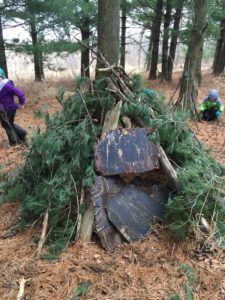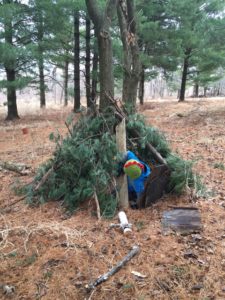Free Range Children
For the past forty or so years, researchers who study the outdoor play and learning of children have noted the kids preference for enclosed green spaces; even as schoolyards become increasingly paved over, and the green is replaced by steel, wood, and plastic structures.
Typical of these studies, in 1988 Mary Ann Kirkby* recorded the minute-by-minute behavior of small children in a schoolyard in Washington State. This particular one had two clumps of bushes in corners plus a slat board “refuge” out on the pavement. These spaces occupied less than 10% of the playground and the children spent 47% of their time in them.
When Kirkby asked these children what they were doing, several trends stood out, which have also been found by other researchers in other locations. One is that they are hiding – they are prey animal avoiding a predator, or a predator lurking, or a good guy scouting the bad guys, or… A second common theme is that they are building some sort of shelter, it might be a castle, or a cabin in the woods, or a lean-to in a storm, or a ship at sea, or…. Small found objects play a big role, pebbles become dinosaur eggs, flowers become decorations or food, pieces of bark become plates or small animal cages, a feather becomes a bird, plus there are seeds, fruits, leaves, pinecones, bugs, etc, all waiting to be transformed in a child’s imagination.
Most researchers conclude that free-style unstructured imaginative play in nature is excellent for children’s development, both for their mental health and for their physical health. Even for children who already have issues, introducing them to a green lifestyle, sometimes as simple as a walk in the woods, often helps their attention span, decreases their hostility, improves self-confidence, decreases anxiety, etc. In some cases a regular dose of green produces more benefits than medication, and in other cases supplements it.





Above photos: Prairie Green School free range children at Bur Oak Land Trust’s Belgum Grove property, gifted by a storm that left behind white pine branches. Kathie and David Belgum probably never guessed that they were contributing to child development when they planted those seedling pines a half-century ago.
Citation: Kirkby, Mary Ann. “Nature as Refuge in Children’s Environments.” Children’s Environments Quarterly, vol. 6, no. 1, 1989, pp. 7–12. JSTOR, JSTOR, www.jstor.org/stable/41515227.
Tags: children and nature, Lon Drake, Prairie Green School

